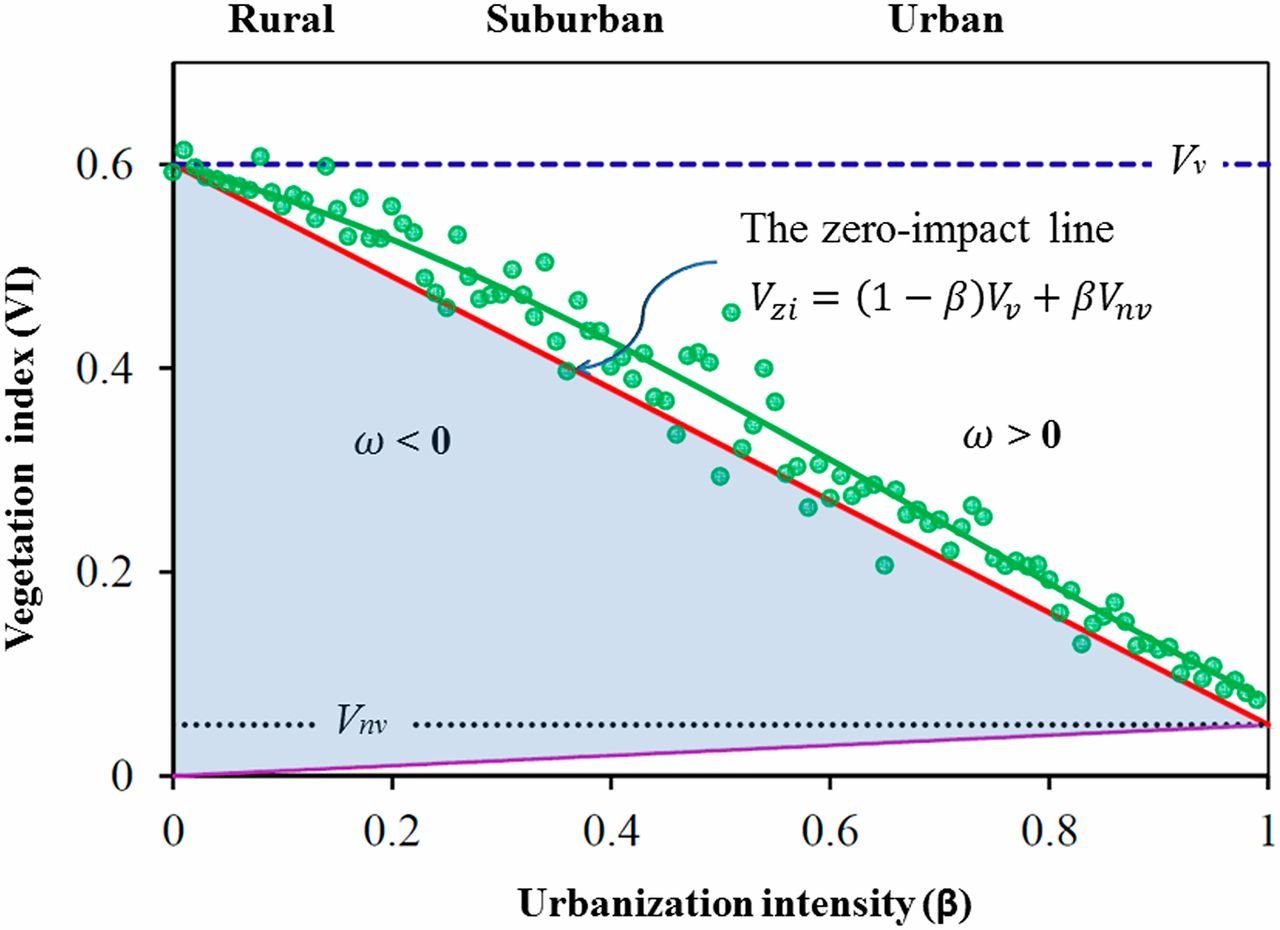文章信息:Shuqing Zhao, Shuguang Liu, & Decheng Zhou. (2016). Prevalent vegetation growth enhancement in urban environment. Proceedings of the National Academy of Sciences: 113(22), 6313–6318. https://doi.org/10.1073/pnas.1602312113
整理人:杨文,2023级硕士生
整理时间:2024年8月13日
Abstract: Urbanization, a dominant global demographic trend, leads to various changes in environments (e.g., atmospheric CO2 increase, urban heat island). Cities experience global change decades ahead of other systems so that they are natural laboratories for studying responses of other nonurban biological ecosystems to future global change. However, the impacts of urbanization on vegetation growth are not well understood. Here, we developed a general conceptual framework for quantifying the impacts of urbanization on vegetation growth and applied it in 32 Chinese cities. Results indicated that vegetation growth, as surrogated by satellite-observed vegetation index, decreased along urban intensity across all cities. At the same time, vegetation growth was enhanced at 85% of the places along the intensity gradient, and the relative enhancement increased with urban intensity. This growth enhancement offset about 40% of direct loss of vegetation productivity caused by replacing productive vegetated surfaces with nonproductive impervious surfaces. In light of current and previous field studies, we conclude that vegetation growth enhancement is prevalent in urban settings. Urban environments do provide ideal natural laboratories to observe biological responses to environmental changes that are difficult to mimic in manipulative experiments. However, one should be careful in extrapolating the finding to nonurban environments because urban vegetation is usually intensively managed, and attribution of the responses to diverse driving forces will be challenging but must be pursued.
摘要:城市化是一种占主导地位的全球人口趋势,导致环境发生各种变化(例如,大气二氧化碳增加、城市热岛)。城市比其他系统经历了几十年的全球变化,因此它们是研究其他非城市生物生态系统对未来全球变化反应的自然实验室。然而,城市化对植被生长的影响尚不清楚。在这里,我们开发了一个用于量化城市化对植被生长影响的一般概念框架,并将其应用于32个中国城市。结果表明,用卫星观测植被指数代替植被生长,所有城市的植被生长都随着城市强度的增加而减少。结果表明,用卫星观测植被指数代替植被生长,所有城市的植被生长都随着城市强度的增加而减少。同时,沿强度梯度85%的地方植被生长增强,相对增强程度随着城市强度的增加而增加。这种生长增强抵消了因用非生产性不透水表面取代生产性植被表面而导致的植被生产力直接损失的约40%。根据目前和以前的实地研究,我们得出结论,植被生长增强在城市环境中很普遍。城市环境确实为观察环境变化的生物反应提供了理想的自然实验室,而这些变化在操纵实验中很难模仿。然而,在将这一发现外推到非城市环境时应该小心,因为城市植被通常是集中管理的,将反应归因于不同的驱动力将是具有挑战性的,但必须加以追求。

图 概念图显示了城市化对城市强度梯度沿线植被条件的影响
在这里,植被状况由VI(无量纲)表示,VI由卫星测量(例如,MODIS的增强VI)。绿点和绿线分别表示观察到的VI值及其回归线。Vv和Vnv分别是农村或潜在植被和非植被城市表面的VI值。紫色实线表示沿城市强度梯度(βVnv)的非植被城市表面对总VI的贡献。无影响(Vzi)由倾斜的红线(即零影响线)表示,负影响(ω<0)将由落在零影响线下的VI表示,正增强(ω>0)将由零影响线上方的VI值表示。

图 示例显示了2011年中国32个城市MODIS EVI(无量纲)对城市强度(β,无量纲)的各种响应
绿线、蓝线和红线分别是观测到的EVI(圆圈)、背景EVI Vv(即回归的y截距)和Vzi或没有城市影响的EVI的三次回归。除拉萨外,所有回归均显著(α=0.05)。

图 EVI与城市强度β之间的关系
2011年中国32个城市的观测EVI(A)、没有城市化影响的EVI(B)、城市化引起的EVI变化(C,A和B之间的差异)、城市主义对EVI的相对影响(D)以及城市化对EVI抵消(τ)(E,中位数的平均值由红线显示)。
原文链接:https://www.pnas.org/doi/10.1073/pnas.1602312113
节选转引:http://pkunews.pku.edu.cn/xxfz/2016-05/17/content_293793.htm